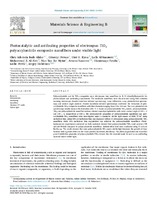| dc.contributor.author | Ademola Bode-Aluko, C | |
| dc.contributor.author | Pereao, O | |
| dc.contributor.author | Kyaw, H.H | |
| dc.date.accessioned | 2021-06-03T07:41:34Z | |
| dc.date.available | 2021-06-03T07:41:34Z | |
| dc.date.issued | 2021 | |
| dc.identifier.citation | Ademola Bode-Aluko, C. et al. (2021). Photocatalytic and antifouling properties of electrospun TiO2 polyacrylonitrile composite nanofibers under visible light. Materials Science and Engineering B: Solid-State Materials for Advanced Technology, 264,114913 | en_US |
| dc.identifier.issn | 09215107 | |
| dc.identifier.uri | 10.1016/j.mseb.2020.114913 | |
| dc.identifier.uri | http://hdl.handle.net/10566/6243 | |
| dc.description.abstract | Polyacrylonitrile and its TiO2 composites were electrospun into nanofibers in N, N’-dimethylformamide for photocatalysis and antifouling experiments. The resultants nanofibers were characterized using field emission scanning microscope, Fourier transform infrared spectroscopy, x-ray diffraction, x-ray photoelectron spectroscopy and contact angle analyses. Fourier transform infrared spectroscopy confirmed the formation of polyacrylonitrile-TiO2 composite nanofibers with their diameter ranging from 10 to 340 nm. The x-ray photoelectron spectroscopy results indicate the formation of O–Ti–C bonds on polyacrylonitrile-TiO2 matrix. polyacrylonitrile-TiO2 and polyacrylonitrile nanofiber surfaces showed superhydrophobicity with water contact angle of 155 ± 1 and 154 ± 1, respectively at 120 s. The photocatalytic properties of polyacrylonitrile nanofibers and polyacrylonitrile-TiO2 nanofibers were investigated under a simulated visible light source of 1000 W/m2 using methylene blue. About 90% of methylene blue was degraded within 3 h of exposure using polyacrylonitrile-TiO2 nanofibers while 55% methylene blue degradation was achieved for polyacrylonitrile nanofibers. | en_US |
| dc.language.iso | en | en_US |
| dc.publisher | Elsevier | en_US |
| dc.subject | Antifouling | en_US |
| dc.subject | Nanofibers | en_US |
| dc.subject | Photocatalysis | en_US |
| dc.subject | Titanium (IV) oxide | en_US |
| dc.subject | Visible light | en_US |
| dc.title | Photocatalytic and antifouling properties of electrospun TiO2 polyacrylonitrile composite nanofibers under visible light | en_US |
| dc.type | Article | en_US |

